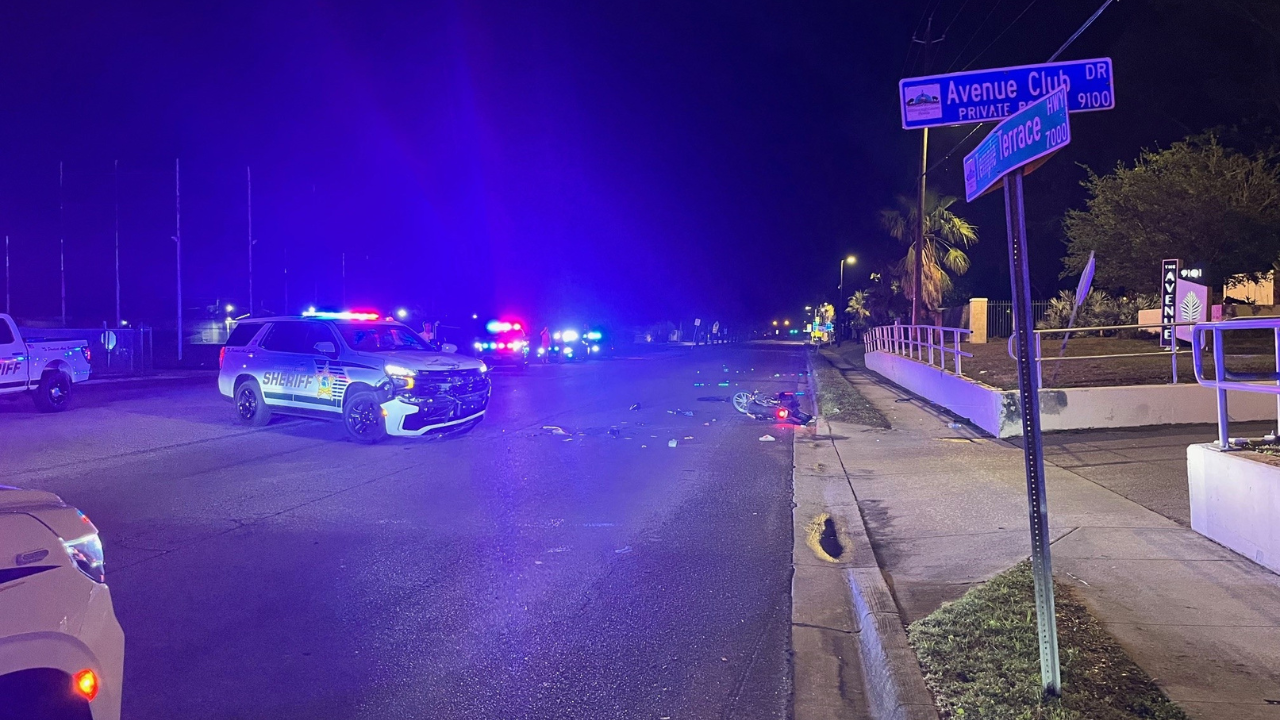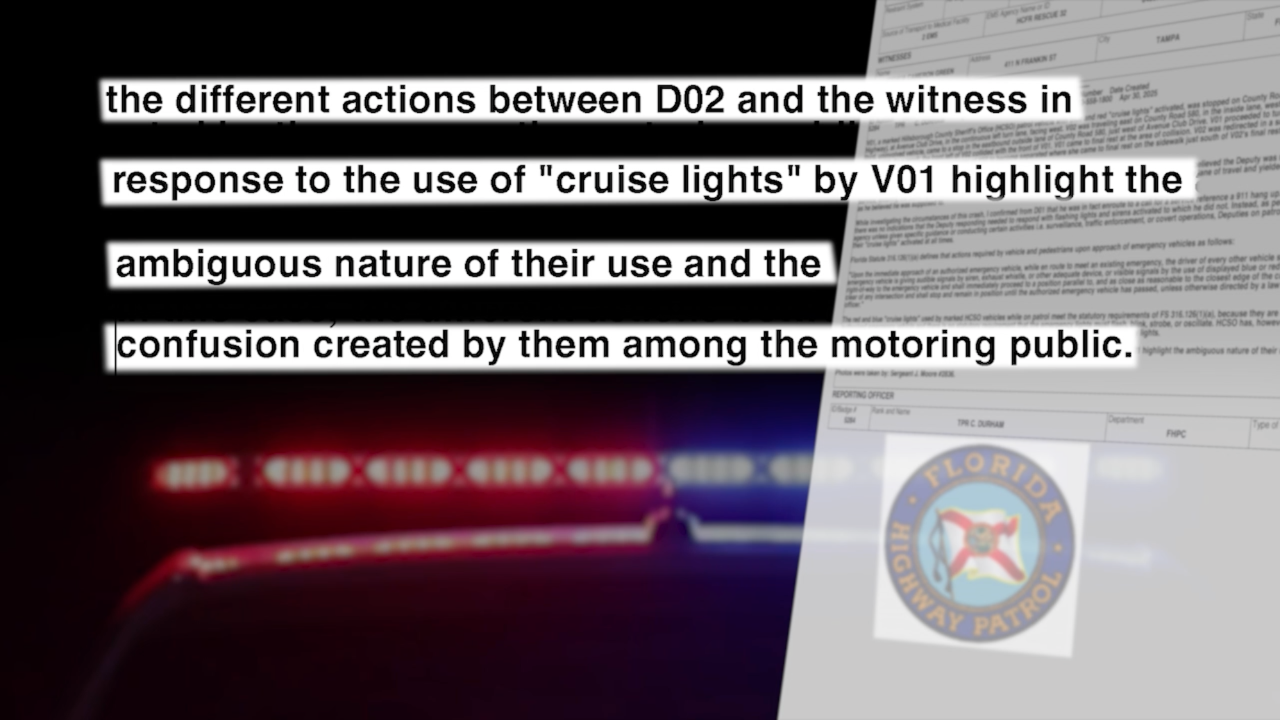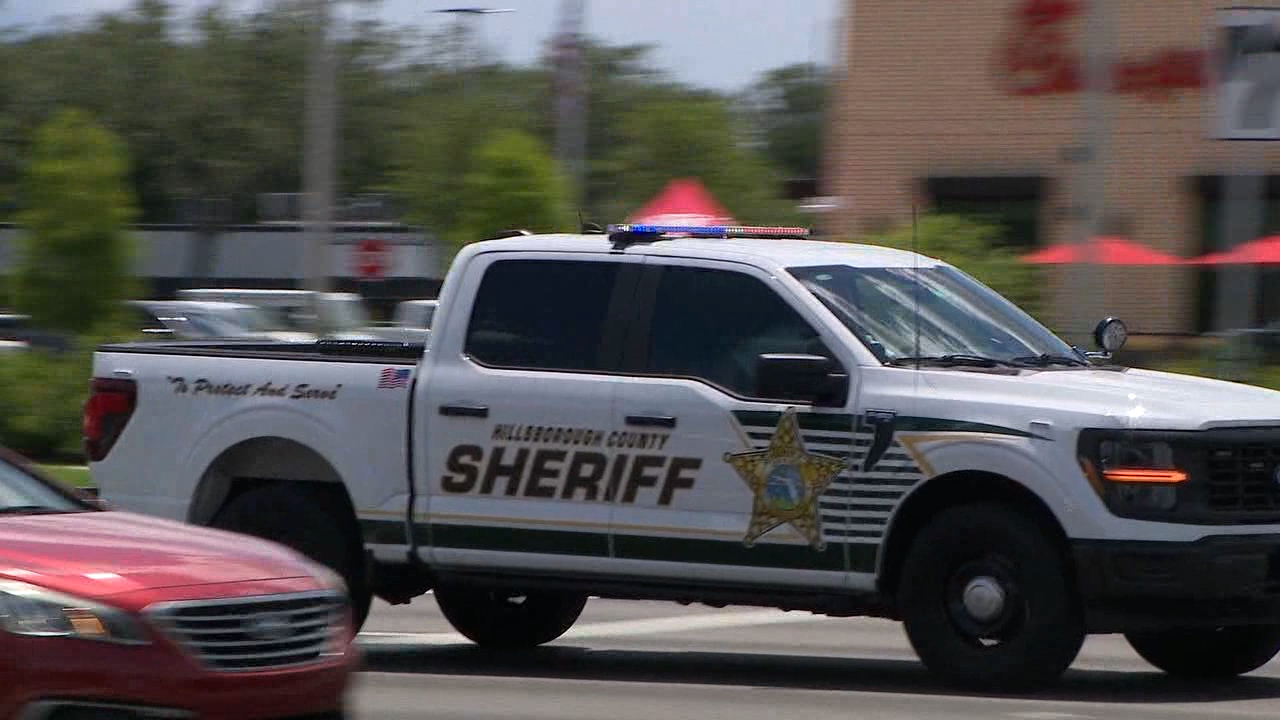HILLSBOROUGH COUNTY, Fla. — Every driver knows that when you see red and blue flashing lights on a patrol car, you slow down, pull over, or get out of the way.
But in Hillsborough County, drivers will also now see deputies with their lights on, but not flashing. They're called "cruise lights," and the Hillsborough County Sheriff's Office (HCSO) recently implemented their use on all patrol vehicles.
Watch full report from Kylie McGivern
It's created confusion about what to do. The sheriff's office says to just keep driving.
Unlike flashing emergency lights, the purpose of cruise lights is simply to increase awareness that law enforcement is there and to deter crime.
But not everyone has received that message.
"If I didn't move the way I did, I'm sure we — we both wouldn't have made it.”
“I haven't seen state troopers use them, I haven't seen Tampa PD use them, Clearwater, Pinellas County, Pasco, it's only Hillsborough County that I've seen that, that uses these. And they create confusion. And as you can see, it can be a danger to the public," Charles Knight told the ABC Action News I-Team.
The I-Team met Knight inside Tampa General Hospital more than a month after a crash with a Hillsborough County deputy, where he was recovering from multiple surgeries to try to save his left leg.
“Yesterday was five weeks, seven surgeries," Knight said. “The surgeons here did an amazing job trying to save my leg, and I'm hoping I get to keep it, but there's a lot of metal in this leg.”
Knight doesn't know the road ahead of him, but when he looks back to April 28, he can see how fractions of a second altered the course of his life.
“Me and my girlfriend at the time, fiancé now, were at CVS picking up some things, and we were heading back home," Knight said.
They were heading home on his Harley.
"There was a car in the right lane, maybe just a few car lengths ahead of me, and we were traveling, and when I noticed Hillsborough County Sheriff's deputy up ahead staging a left-hand turn. As we approach to where the deputy was staging that turn, I noticed this car started to slow down for whatever reason. But I had seen that he had, you know, those red and blue lights on," Knight said.
The deputy had his cruise lights on.
"Since I've been down here, I haven't seen any other agency use them," Knight said. “The car that was to my right had started slowing down, but I knew it was safe to travel through because lights weren't flashing.”
Knight is familiar with cruise lights from his background working in law enforcement in Colorado.
“As he was making that left-hand turn, he completely blocked my lane," Knight said of the deputy. "I tried to get around him, but there just wasn't enough time. I didn't have enough space, and he still ended up hitting me.”


“When I came to, I had already had a tourniquet around my leg, and several more deputies had arrived on scene, and I remember hearing her screaming. My leg’s in pieces. Then we just kept shouting back and forth to each other that we love each other. And that's really all we could do," Knight said. "If I didn't move the way I did, I'm sure we — we both wouldn't have made it.”
The Florida Highway Patrol investigated. In the crash report, the trooper noted HCSO's red and blue cruise lights were activated. The report stated that a driver to Knight's right "came to a stop" and "yielded to the patrol vehicle as he believed he was supposed to do."
The report goes on to say that the different actions taken by Knight on his motorcycle and the other driver in response to the use of cruise lights "highlight the ambiguous nature of their use and the confusion created by them among the motoring public."

“I fully suspect that if the other driver had not slowed down, that this accident would not have occurred," Web Brennan, Knight's attorney, told the I-Team.
"Just keep driving"
To know how to respond to cruise lights in Hillsborough County, you would have to follow their social media accounts. This is where they shared the information. The I-Team wanted more information for this story to share with the public, but the sheriff's office would not do an interview or answer questions and instead pointed the I-Team back to their social media.
In an email, HCSO Public Relations Coordinator Carolina Montelongo told the I-Team, "Given that we have shared multiple videos explaining this process, including the one you referenced, which clearly outlines the purpose of cruise lights and how drivers should respond, we will allow those videos to speak for themselves."
HCSO posted this video two days after Knight's crash.
In the video, the deputy says, "The steady red and blue lights simply mean there’s a deputy in the area patrolling and being visible to the community. If you see these, you don’t need to stop. Just keep driving safely."
The deputy then explains that if the red and blue lights are flashing, the deputy is heading to an emergency or pulling you over.
The 40-second video ends with the deputy saying, "Now that you know this, share this with a friend so they can know what to do when they see the lights.”
"You are conditioned to respond"
Dr. David Thomas, a retired police officer and forensic studies professor at Florida Gulf Coast University, told the I-Team this big of a change demands more communication with the public.
“You are conditioned to react and respond to those lights.” Thomas said. “I know you got well over a million or so people in Hillsborough County. How many of those million people are tied to Hillsborough County's social media? How many of those people who live in different jurisdictions in the cities they are tuned in to Hillsborough County? The SO? So it's short-sighted, and you know, if we're making that deviation, then we owe it to the public, and all the surrounding jurisdictions, to understand that we're making this distinction and why we're doing it.”
HCSO would not discuss cruise lights, so the I-Team submitted a public records request.
The I-Team obtained documents showing the results of a 6-month trial period the sheriff's office conducted, starting in December 2019.

There were some drops in crime noted during the trial period. But a key finding stated, "This study was not able to conclusively support the argument that cruise lights deter crime. The study demonstrated a possible deterrent effect."
Knight remains focused on his recovery.
“Just trying to keep my mind busy and trying to stay as positive as possible. Luckily, I have my mom and family here, so trying to stay positive best I can. That's all you can do," he said.
And he has his fiancé, who had to undergo six surgeries herself.
"I'm grateful I have her, because if I was going through this alone, I could tell you I wouldn't be this positive. So having her has been a blessing," Knight said.
He proposed to her while they were in the hospital.
“I just felt like the two of us going through something as tragic as this and getting through it, it seemed like maybe she, you know — we're meant," Knight said.

Knight said that as he works to move forward in his life, he still worries about cruise lights, particularly the potential consequences of confusion.
"It still creates a danger to people traveling on the road," Knight said.
“The reward... far outweighs some folks feeling like they don't quite know what to do for a moment."
To gain more perspective, I-Team traveled further south, to Bradenton, where the police department has been using cruise lights for nearly a year.
“I’ll be honest, when it started, we got some pushback, not only from the cops, but also from the public," Bradenton Police Chief Melanie Bevan said. "However, in the months that have passed, that has shifted from, 'What the heck are you guys doing?' To, 'Wow, I like that. It really catches our attention. We feel like you have more police officers out there.'"
When asked about the pushback, Bevan said the concerns centered around change.
"It's something that people aren't used to. I think some people see a cruiser to their side or coming up behind it, and they think we need to pull over," Bevan said.
She reiterated that cruise lights are to raise awareness, and drivers do not need to pull over.
“The reward, what I think we're benefiting from a program like this, far outweighs some folks feeling like they don't quite know what to do for a moment. It does require a great deal of education. We need to let everybody know what it's all about. But at the end of the day, I think it's worth it," Bevan said. “It just gives a greater degree of visibility to our folks out there on the street, and lets people know that we're there, we're prepared, and here we are.”
This story began with a tip. If you have something you'd like the I-Team to investigate, contact Kylie:

Parents weigh in on Florida’s new cellphone ban for K-8 students
Florida's K-8 cellphone ban in schools draws mixed reactions from parents concerned about safety, distractions, and staying connected during the school day.





